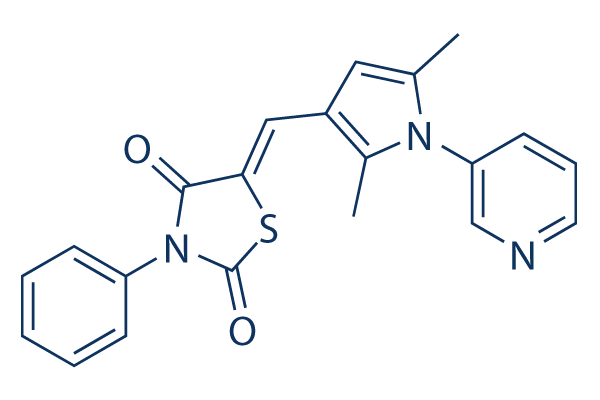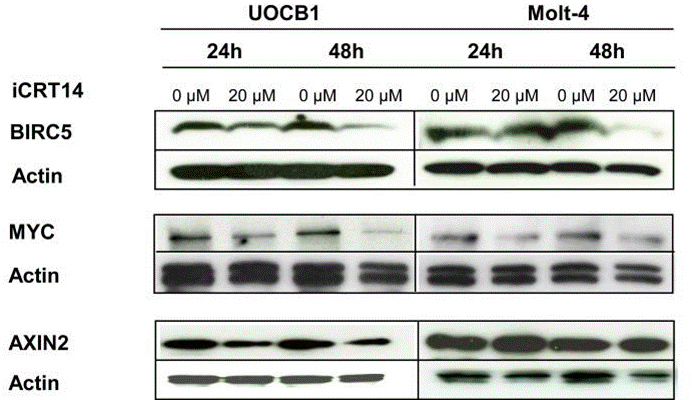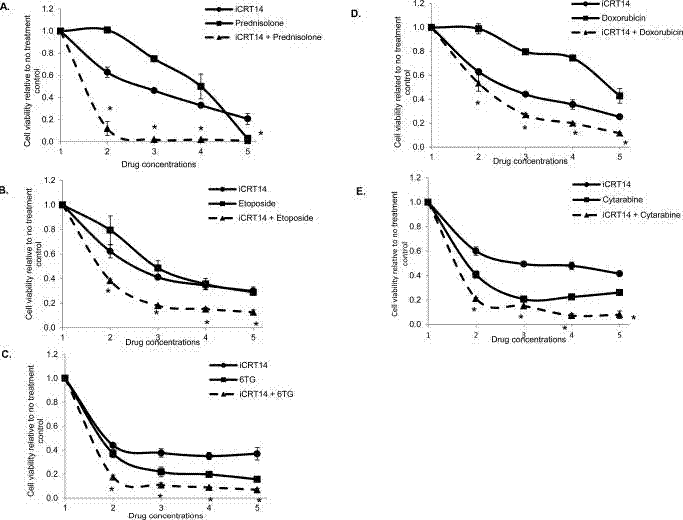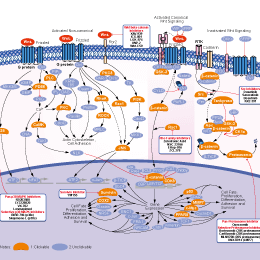
- Bioactive Compounds
- By Signaling Pathways
- PI3K/Akt/mTOR
- Epigenetics
- Methylation
- Immunology & Inflammation
- Protein Tyrosine Kinase
- Angiogenesis
- Apoptosis
- Autophagy
- ER stress & UPR
- JAK/STAT
- MAPK
- Cytoskeletal Signaling
- Cell Cycle
- TGF-beta/Smad
- DNA Damage/DNA Repair
- Compound Libraries
- Popular Compound Libraries
- Customize Library
- Clinical and FDA-approved Related
- Bioactive Compound Libraries
- Inhibitor Related
- Natural Product Related
- Metabolism Related
- Cell Death Related
- By Signaling Pathway
- By Disease
- Anti-infection and Antiviral Related
- Neuronal and Immunology Related
- Fragment and Covalent Related
- FDA-approved Drug Library
- FDA-approved & Passed Phase I Drug Library
- Preclinical/Clinical Compound Library
- Bioactive Compound Library-I
- Bioactive Compound Library-Ⅱ
- Kinase Inhibitor Library
- Express-Pick Library
- Natural Product Library
- Human Endogenous Metabolite Compound Library
- Alkaloid Compound LibraryNew
- Angiogenesis Related compound Library
- Anti-Aging Compound Library
- Anti-alzheimer Disease Compound Library
- Antibiotics compound Library
- Anti-cancer Compound Library
- Anti-cancer Compound Library-Ⅱ
- Anti-cancer Metabolism Compound Library
- Anti-Cardiovascular Disease Compound Library
- Anti-diabetic Compound Library
- Anti-infection Compound Library
- Antioxidant Compound Library
- Anti-parasitic Compound Library
- Antiviral Compound Library
- Apoptosis Compound Library
- Autophagy Compound Library
- Calcium Channel Blocker LibraryNew
- Cambridge Cancer Compound Library
- Carbohydrate Metabolism Compound LibraryNew
- Cell Cycle compound library
- CNS-Penetrant Compound Library
- Covalent Inhibitor Library
- Cytokine Inhibitor LibraryNew
- Cytoskeletal Signaling Pathway Compound Library
- DNA Damage/DNA Repair compound Library
- Drug-like Compound Library
- Endoplasmic Reticulum Stress Compound Library
- Epigenetics Compound Library
- Exosome Secretion Related Compound LibraryNew
- FDA-approved Anticancer Drug LibraryNew
- Ferroptosis Compound Library
- Flavonoid Compound Library
- Fragment Library
- Glutamine Metabolism Compound Library
- Glycolysis Compound Library
- GPCR Compound Library
- Gut Microbial Metabolite Library
- HIF-1 Signaling Pathway Compound Library
- Highly Selective Inhibitor Library
- Histone modification compound library
- HTS Library for Drug Discovery
- Human Hormone Related Compound LibraryNew
- Human Transcription Factor Compound LibraryNew
- Immunology/Inflammation Compound Library
- Inhibitor Library
- Ion Channel Ligand Library
- JAK/STAT compound library
- Lipid Metabolism Compound LibraryNew
- Macrocyclic Compound Library
- MAPK Inhibitor Library
- Medicine Food Homology Compound Library
- Metabolism Compound Library
- Methylation Compound Library
- Mouse Metabolite Compound LibraryNew
- Natural Organic Compound Library
- Neuronal Signaling Compound Library
- NF-κB Signaling Compound Library
- Nucleoside Analogue Library
- Obesity Compound Library
- Oxidative Stress Compound LibraryNew
- Plant Extract Library
- Phenotypic Screening Library
- PI3K/Akt Inhibitor Library
- Protease Inhibitor Library
- Protein-protein Interaction Inhibitor Library
- Pyroptosis Compound Library
- Small Molecule Immuno-Oncology Compound Library
- Mitochondria-Targeted Compound LibraryNew
- Stem Cell Differentiation Compound LibraryNew
- Stem Cell Signaling Compound Library
- Natural Phenol Compound LibraryNew
- Natural Terpenoid Compound LibraryNew
- TGF-beta/Smad compound library
- Traditional Chinese Medicine Library
- Tyrosine Kinase Inhibitor Library
- Ubiquitination Compound Library
-
Cherry Picking
You can personalize your library with chemicals from within Selleck's inventory. Build the right library for your research endeavors by choosing from compounds in all of our available libraries.
Please contact us at info@selleckchem.com to customize your library.
You could select:
- Antibodies
- Bioreagents
- qPCR
- 2x SYBR Green qPCR Master Mix
- 2x SYBR Green qPCR Master Mix(Low ROX)
- 2x SYBR Green qPCR Master Mix(High ROX)
- Protein Assay
- Protein A/G Magnetic Beads for IP
- Anti-Flag magnetic beads
- Anti-Flag Affinity Gel
- Anti-Myc magnetic beads
- Anti-HA magnetic beads
- Magnetic Separator
- Poly DYKDDDDK Tag Peptide lyophilized powder
- Protease Inhibitor Cocktail
- Protease Inhibitor Cocktail (EDTA-Free, 100X in DMSO)
- Phosphatase Inhibitor Cocktail (2 Tubes, 100X)
- Cell Biology
- Cell Counting Kit-8 (CCK-8)
- Animal Experiment
- Mouse Direct PCR Kit (For Genotyping)
- New Products
- Contact Us
iCRT14
iCRT14 is a β-catenin/Tcf inhibitor with a Ki value of 54 ± 5.2 μM in homogeneous fluorescence polarization (FP) assay.

iCRT14 Chemical Structure
CAS No. 677331-12-3
Purity & Quality Control
Batch:
S870401
DMSO]37 mg/mL]false]Water]Insoluble]false]Ethanol]Insoluble]false
Purity:
99.86%
99.86
iCRT14 Related Products
| Related Targets | WNT β-catenin Wnt/β-catenin | Click to Expand |
|---|---|---|
| Related Products | IWR-1-endo IWP-2 SKL2001 BML-284 (Wnt agonist 1) PRI-724 Salinomycin (from Streptomyces albus) FH535 PNU-74654 LF3 KYA1797K KY02111 iCRT3 Adavivint (SM04690) MSAB Isoquercitrin IQ-1 CCT251545 Isoxazole 9 (ISX-9) JW55 Methyl Vanillate M435-1279 WAY-262611 JW74 | Click to Expand |
| Related Compound Libraries | Kinase Inhibitor Library FDA-approved Drug Library Stem Cell Signaling Compound Library GPCR Compound Library Stem Cell Differentiation Compound Library | Click to Expand |
Signaling Pathway
Biological Activity
| Description | iCRT14 is a β-catenin/Tcf inhibitor with a Ki value of 54 ± 5.2 μM in homogeneous fluorescence polarization (FP) assay. | ||
|---|---|---|---|
| Targets |
|
| In vitro | ||||
| In vitro | iCRT14 suppresses the transcriptional activity of canonical Wnt signaling, downregulates Wnt/β-catenin-induced target genes, and inhibits the growth of colorectal cancer cells in vitro[1]. iCRT14 shows a modest reduction in the amount of Dvl but has no effect on Dvl phosphorylation itself. iCRT14 inhibits the Wnt responsive STF16-luc reporter in mammalian HEK293 cells with an IC50 of 40.3 nM. iCRT14 can also interfere with TCF binding to DNA in addition to its ability to influence TCF-β-catenin interaction[2]. |
|||
|---|---|---|---|---|
| Cell Research | Cell lines | Rat2 cells | ||
| Concentrations | 25 and 50 μM | |||
| Incubation Time | 2 h | |||
| Method | Rat2 cells are pretreated with iCRTs at the indicated doses and stimulated for 2 h with Wnt3a or Wnt5a. Cell lysate is harvested for western analysis of Dvl2 phosphorylation. |
|||
| Experimental Result Images | Methods | Biomarkers | Images | PMID |
| Western blot | BIRC5 / Myc / Axin2 caspase 3 / cleaved caspase 3 / cleaved PARP Snail / pS9-GSK-3β / GSK-3β / Akt1 / Akt2 |

|
24995804 | |
| Growth inhibition assay | Cell viability |

|
24995804 | |
| In Vivo | ||
| In vivo | Administration of iCRT14 to the HCT116 and HT29 xenograft models reveals a marked decrease in CycD1, coincided with reduced proliferation of the tumors. Furthermore, these effects are correlated with a marked reduction (∼50%) in the initial growth rate of tumors within the first 3 wk (∼day 19) of compound administration. After day 19, however, the rate of tumor growth is comparable with that of DMSO-treated control. Throughout the course of the study, the mice does not display any signs of systemic toxicity or weight loss that would indicate off-target or nonspecific effects. The compound may be metabolized rapidly in vivo, thus reducing its bioavailability[2]. |
|
|---|---|---|
| Animal Research | Animal Models | HCT116 and HT29 xenograft models (implanted tumor cells in athymic nude mice) |
| Dosages | 50 mg/kg | |
| Administration | i.p. | |
Chemical Information & Solubility
| Molecular Weight | 375.44 | Formula | C21H17N3O2S |
| CAS No. | 677331-12-3 | SDF | -- |
| Smiles | CC1=CC(=C(N1C2=CN=CC=C2)C)C=C3C(=O)N(C(=O)S3)C4=CC=CC=C4 | ||
| Storage (From the date of receipt) | 3 years -20°C powder | ||
|
In vitro |
DMSO : 37 mg/mL ( (98.55 mM) Moisture-absorbing DMSO reduces solubility. Please use fresh DMSO.) Water : Insoluble Ethanol : Insoluble |
Molecular Weight Calculator |
|
In vivo Add solvents to the product individually and in order. |
In vivo Formulation Calculator |
||||
Preparing Stock Solutions
Molarity Calculator
In vivo Formulation Calculator (Clear solution)
Step 1: Enter information below (Recommended: An additional animal making an allowance for loss during the experiment)
mg/kg
g
μL
Step 2: Enter the in vivo formulation (This is only the calculator, not formulation. Please contact us first if there is no in vivo formulation at the solubility Section.)
% DMSO
%
% Tween 80
% ddH2O
%DMSO
%
Calculation results:
Working concentration: mg/ml;
Method for preparing DMSO master liquid: mg drug pre-dissolved in μL DMSO ( Master liquid concentration mg/mL, Please contact us first if the concentration exceeds the DMSO solubility of the batch of drug. )
Method for preparing in vivo formulation: Take μL DMSO master liquid, next addμL PEG300, mix and clarify, next addμL Tween 80, mix and clarify, next add μL ddH2O, mix and clarify.
Method for preparing in vivo formulation: Take μL DMSO master liquid, next add μL Corn oil, mix and clarify.
Note: 1. Please make sure the liquid is clear before adding the next solvent.
2. Be sure to add the solvent(s) in order. You must ensure that the solution obtained, in the previous addition, is a clear solution before proceeding to add the next solvent. Physical methods such
as vortex, ultrasound or hot water bath can be used to aid dissolving.
Tech Support
Answers to questions you may have can be found in the inhibitor handling instructions. Topics include how to prepare stock solutions, how to store inhibitors, and issues that need special attention for cell-based assays and animal experiments.
Tel: +1-832-582-8158 Ext:3
If you have any other enquiries, please leave a message.
* Indicates a Required Field
Tags: buy iCRT14 | iCRT14 supplier | purchase iCRT14 | iCRT14 cost | iCRT14 manufacturer | order iCRT14 | iCRT14 distributor







































